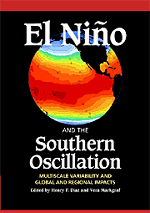Book contents
- Frontmatter
- Contents
- Contributors
- Acknowledgments
- Preface
- SECTION A Global and Regional Characteristics and Impacts of ENSO Variability
- SECTION B Long-Term Changes in ENSO: Historical, Paleoclimatic, and Theoretical Aspects
- 7 The Documented Historical Record of El Niño Events in Peru: An Update of the Quinn Record (Sixteenth through Nineteenth Centuries)
- 8 Tree-Ring Records of Past ENSO Variability and Forcing
- 9 The Tropical Ice Core Record of ENSO
- 10 Long-Term Variability in the El Niño/Southern Oscillation and Associated Teleconnections
- 11 Modulation of ENSO Variability on Decadal and Longer Timescales
- 12 Global Climate Change and El Niño: A Theoretical Framework
- 13 The Past ENSO Record: A Synthesis
- Index
10 - Long-Term Variability in the El Niño/Southern Oscillation and Associated Teleconnections
from SECTION B - Long-Term Changes in ENSO: Historical, Paleoclimatic, and Theoretical Aspects
Published online by Cambridge University Press: 04 August 2010
- Frontmatter
- Contents
- Contributors
- Acknowledgments
- Preface
- SECTION A Global and Regional Characteristics and Impacts of ENSO Variability
- SECTION B Long-Term Changes in ENSO: Historical, Paleoclimatic, and Theoretical Aspects
- 7 The Documented Historical Record of El Niño Events in Peru: An Update of the Quinn Record (Sixteenth through Nineteenth Centuries)
- 8 Tree-Ring Records of Past ENSO Variability and Forcing
- 9 The Tropical Ice Core Record of ENSO
- 10 Long-Term Variability in the El Niño/Southern Oscillation and Associated Teleconnections
- 11 Modulation of ENSO Variability on Decadal and Longer Timescales
- 12 Global Climate Change and El Niño: A Theoretical Framework
- 13 The Past ENSO Record: A Synthesis
- Index
Summary
Abstract
We analyze global patterns of reconstructed surface temperature for insights into the behavior of the El Nino/Southern Oscillation (ENSO) and related climatic variability during the past three centuries. The global temperature reconstructions are based on calibrations of a large set of globally distributed proxy records, or “multiproxy” data, against the dominant patterns of surface temperature during the past century. These calibrations allow us to estimate large-scale surface temperature patterns back in time. The reconstructed eastern equatorial Pacific “Niño-3” areal-mean sea surface temperature (SST) index is used as a direct diagnostic of El Niño itself, while the global ENSO phenomenon is analyzed based on the full global temperature fields. We document low-frequency changes in the base state, amplitude of interannual variability, and extremes in El Niño, as well as in the global pattern of ENSO variability. Recent anomalous behavior in both El Nino and the global ENSO is interpreted in the context of the long-term reconstructed history and possible forcing mechanisms. The mean state of ENSO and its global patterns of influence, amplitude of interannual variability, and frequency of extreme events show considerable multidecadal and century-scale variability over the past several centuries. Many of these changes appear to be related to changes in global climate, and the histories of external forcing agents, including recent anthropogenic forcing.
- Type
- Chapter
- Information
- El Niño and the Southern OscillationMultiscale Variability and Global and Regional Impacts, pp. 357 - 410Publisher: Cambridge University PressPrint publication year: 2000
- 11
- Cited by



